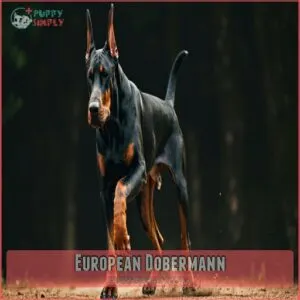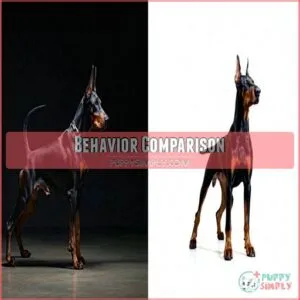This site is supported by our readers. We may earn a commission, at no cost to you, if you purchase through links.
 Looking for a powerful, muscular guardian? The European Doberman’s your breed.
Looking for a powerful, muscular guardian? The European Doberman’s your breed.
Bigger and bolder than its American cousin, this dog’s built for serious work. You’ll get a larger, more assertive companion with a broader head and serious protective instincts.
They’re not just pets—they’re purpose-driven partners who take guarding seriously. Expect intense training needs and a slower mental maturity around 3 years. They require consistent, firm handling and plenty of exercise.
Genetically screened with lower health risks, European Dobermans bring top-tier performance to the table. Want a dog that’ll make other breeds look like amateurs? Your search ends here.
Table Of Contents
- Key Takeaways
- Comparing American Vs European Doberman
- Physical Differences
- Color Differences
- Behavior Comparison
- Assertiveness
- Training Style
- Age at Mental Maturity
- Energy Levels
- Health Differences
- Are European Dobermans Good Guard Dogs?
- Frequently Asked Questions (FAQs)
- What is the difference between a European and American Doberman?
- How much do European Dobermans cost?
- What is the life span of a European Doberman?
- Which is better, a Rottweiler or a Doberman?
- What climate is best suited for a European Doberman?
- How often should I brush my European Doberman’s coat?
- What type of toys and activities do European Dobermans enjoy?
- What is the average lifespan of a European Doberman?
- How can I find a responsible European Doberman breeder near me?
- Can European Dobermans live in small apartments?
- Conclusion
Key Takeaways
- You’ll get a larger, more muscular guard dog with a serious attitude and strong protective instincts in a European Doberman.
- They have stricter health standards and better genetic resilience, leading to lower health risks compared to American Dobermans.
- Training a European Doberman takes patience and discipline; they demand firm guidance, consistent boundaries, and plenty of exercise.
- These working dogs need mental stimulation and intense daily activity to channel their high energy levels and prevent behavior issues.
Comparing American Vs European Doberman
Ever wondered what sets American and European Dobermans apart?
You’ll be shocked to discover the jaw-dropping differences between these two remarkable canine cousins
that’ll make you see these powerful pups in a whole new light.
American Doberman Vs European Doberman: Size
Sizing up Dobermanns reveals a muscular showdown between American and European lines.
These canine powerhouses differ dramatically in stature, with European Dobermanns boasting more impressive physiques.
| Breed | Height | Weight |
|---|---|---|
| American | 24-28" | 60-100 lbs |
| European | 25-29" | 70-100 lbs |
Their bone-crushing build speaks volumes about breed heritage and purpose.
American Doberman Vs European Doberman: Appearance
After comparing Doberman sizes, you’ll want to zoom in on their striking appearances that set American and European lines apart. These canine cousins might look similar at first glance, but their build tells a different story.
This difference in appearance is also reflected in their recognized colors, including the colors of dobermans, which vary in rarity and health concerns.
| Feature | American Doberman | European Doberman |
|---|---|---|
| Head Shape | Refined, narrow | Broader, muscular |
| Coat Texture | Sleek, fine | Thick, robust |
| Muzzle Length | Slender | Robust |
| Eye Color | Lighter brown | Darker brown |
Think of the American Doberman as the runway model and the European as the heavyweight boxer. One’s bred for show, the other for work. Their appearances reflect generations of purposeful breeding, telling a visual story of form following function in these magnificent dogs.
American Doberman Vs European Doberman: Ancestry and Purpose
From sleek show dogs to fierce working guardians, the American and European Dobermans have traveled different paths since their German roots.
One breed evolved for family cuddles, the other for sharp-eyed protection.
Their divergence tells a tale of selective breeding that transformed a single bloodline into two distinct personalities.
| Breed Origin | Modern Purpose |
|---|---|
| German Working Dog | Family Companion |
| Louis Dobermann’s Vision | Refined Protector |
| Military & Police Heritage | Emotional Support |
| Fierce Guardian Instincts | Gentle Companion |
American Doberman Vs European Doberman: Behavior
When diving into Doberman temperament, you’ll quickly spot key behavioral differences. The European and American lines march to different rhythms, each packed with unique personality quirks that’ll make dog lovers sit up and take notice.
| Trait | European Doberman | American Doberman |
|---|---|---|
| Assertiveness | High | Moderate |
| Training Adaptability | Requires firm direction | Responds to positive reinforcement |
| Mental Maturity | Slower (3 years) | Faster (2 years) |
Both breeds share unwavering loyalty, but their approaches to family life and protection vary dramatically.
American Doberman Vs European Doberman: Lifespan
Ready to unravel the mystery of Doberman longevity? Your loyal companion’s lifespan isn’t just a roll of the dice.
For example, a detailed comparison of <strong>American and European Dobermans</strong> reveals interesting insights into breed health.
| Breed Factor | European | American |
|---|---|---|
| Avg Lifespan | 10-12 years | 9-11 years |
| Genetic Screening | High | Moderate |
| Health Risks | Lower | Higher |
Their robust genetics and more rigorous health standards mean these dogs aren’t just pets—they’re long-term family guardians who stick around longer and stronger.
Physical Differences
You’re about to uncover the jaw-dropping physical differences between American and European Dobermans that’ll make your head spin!
From muscular builds to distinctive markings, these stunning canines are more than just your average guard dogs, and you’ll want to know exactly what sets them apart.
American Doberman Pinscher
Picture your dream guard dog with a show-stopping physique. The American Doberman Pinscher struts into your life with an elegant, muscular frame that turns heads.
Standing 24-28 inches tall for males and 22-26 inches for females, these stunners weigh between 55-80 pounds of pure athletic prowess.
With a wedge-shaped head and keen expression, they’re the supermodels of the dog world – bred for looks and loyalty.
Expect a responsive companion who thrives on positive reinforcement and loves to please. This breed is known for its elegant, muscular frame.
European Dobermann
If the American Doberman’s sleek lines caught your eye, get ready to meet the European powerhouse.
European Dobermanns pack more muscle and brawn into a compact frame, built like a well-oiled machine compared to their show-dog cousins. These dogs aren’t just about looks—they’re working dogs with serious attitude.
With a broader chest, thicker coat, and more intense build, European Dobermanns represent pure canine performance. They’re the kind of dog that turns heads and demands respect, whether patrolling a property or strutting down the street.
Color Differences
Discover the vibrant world of Doberman coat colors, where genetics paint a stunning canvas of canine diversity.
European Dobermans rock a strict black and rust or brown and rust palette, while American Dobermans break the mold with bold blue and fawn variations.
Understanding the unique Doberman coat colors genetics can help you better appreciate these differences.
- Imagine a midnight-black Doberman with rust highlights glowing like embers
- Picture a rare fawn coat shimmering in afternoon sunlight
- Envision deep brown eyes that speak of heritage
Color differences don’t compromise their legendary spirit – they celebrate it.
Behavior Comparison
Got colors down? Now let’s talk temperament – where these elegant canines really show their stripes. Your choice between an American or European Doberman hinges on their core behavior.
| Trait | American Doberman | European Dobermann |
|---|---|---|
| Personality | People-pleaser | Guard dog |
| Training Style | Gentle | Firm |
| Family Fit | Highly adaptable | More selective |
European Dobermanns pack a protective punch, bred for serious work with razor-sharp instincts.
Their American cousins? They’re the family-friendly version – loyal, loving, and keen to cuddle.
Where European Dobermans demand a seasoned handler, American Dobermans welcome first-time owners with open paws. Your lifestyle, energy level, and training commitment will determine which flavor of this magnificent breed matches your world perfectly.
Assertiveness
Doberman assertiveness isn’t just a trait—it’s a personality blueprint that separates the American and European lines.
Your European Dobermann comes wired with an intensity that screams "working dog" from the moment they’re born. While American Dobermans lean in the direction of family-friendly vibes, their European cousins bring a serious, no-nonsense energy that demands respect.
Think of them as the special forces of the canine world—laser-focused, razor-sharp, and always ready to take charge. Their assertiveness stems from generations of rigorous breeding for protection and working roles.
To effectively manage their strong personality, consider investing in Doberman assertiveness training programs.
Managing this powerful temperament requires more than basic obedience—you’ll need consistent training, clear boundaries, and a confident approach that matches their bold spirit.
Are you up for the challenge?
Training Style
Training techniques are the heartbeat of transforming your Doberman into a well-oiled companion. American and European Dobermans demand nuanced approaches that tap into their unique temperaments.
Your European Dobermann craves structured commands and firm direction, responding best to clear, assertive training methods that channel its working dog heritage. In contrast, the American Doberman thrives on positive reinforcement, enthusiastically soaking up praise and treats during skill development. A dog’s individual temperament, which can vary considerably regardless of origin, is a key factor in its suitability for service work, as noted in doberman service work.
| Breed | Preferred Training Style | Example Techniques |
|---|---|---|
| American Doberman | Positive Reinforcement | Treats, praise, clicker training |
| European Doberman | Clear, Firm Direction | Corrections, structured commands |
Consistency is your secret weapon. Whether you’re working with an American or European line, early socialization and problem-solving techniques will release your dog’s true potential.
Release and considerably are the correct alternatives to unlock and significantly.
Age at Mental Maturity
In the winding road of European Doberman development, mental maturity is a journey that’ll test your patience and training skills.
Here’s the lowdown on your pup’s cognitive growth:
- Slower Learning Curve: Expect a mental marathon, not a sprint.
- Boundary Testing: Your furry friend will challenge your authority well into their second year.
- Playful Persistence: Puppy-like behavior lingers longer than you’d imagine.
Some European Dobermans may still be developing their bite work skills at 12 months of age. Statistically speaking, only 58.3% of European Dobermans reach mental maturity by age two. Most will take up to 30 months to fully settle into adult temperament. Your training approach matters hugely – positive reinforcement is key. Bred for working prowess, these dogs prioritize capability over early compliance. Stay consistent, patient, and understand that your European Doberman’s mental development is a unique, sometimes unpredictable journey.
Energy Levels
Because every powerful dog breed has its unique pulse, your Doberman’s energy levels will make or break your partnership.
European Dobermans pack a serious punch with their high-octane lifestyle, demanding 60-90 minutes of intense daily exercise – they’re the epitome of canine athletes waiting to be set free. American Dobermans, by contrast, bring a more laid-back vibe, requiring 30-60 minutes of activity.
To manage their energy and prevent behavior problems, providing them with sufficient physical activity and mental stimulation is vital, such as daily exercise and mental stimulation.
| Breed | Energy Level | Exercise Needs |
|---|---|---|
| European Doberman | Very High | 60-90 mins/day |
| American Doberman | High | 30-60 mins/day |
Ignoring these energy differences can have serious consequences. Without proper outlets, your furry companion might transform from loyal friend to household tornado. Whether you’re eyeing a high-voltage European or a more balanced American, understanding their energy blueprint is your ticket to harmony.
Health Differences
The health of your Doberman might just be a genetic lottery, with European and American lines presenting different odds.
European Dobermans boast superior genetic resilience, thanks to rigorous breeding standards that prioritize health over appearance. Here’s what you need to know about their wellness journey:
- Lower rates of hip dysplasia and cardiomyopathy
- More selective breeding practices
- Fewer autoimmune and metabolic disorders
- Stricter health screening protocols
- Enhanced longevity potential
When it comes to maintaining your Doberman’s health, using European Doberman health products can also be a valuable way to support their well-being.
American Dobermans often struggle with genetic predispositions, including skin conditions and cardiac issues. Unfortunately, this is also true for skin issues. Your veterinarian becomes your ultimate ally, helping you navigate breed-specific health challenges and develop a personalized prevention strategy that keeps your loyal companion thriving for years to come.
Are European Dobermans Good Guard Dogs?
Want a guard dog with muscles of steel and nerves of titanium? European Dobermans deliver knockout protective instincts straight out of the box.
These powerhouse Doberman Pinschers weren’t just bred – they were engineered for security, blending razor-sharp intelligence with unbreakable loyalty. Their protective temperament transforms them into living, breathing security systems that’ll make intruders think twice.
But here’s the catch: these guard dogs demand serious training and socialization, and their breeding standards can vary markedly between American vs. European Dobermans.
You can’t just point and expect miracles – they need consistent guidance to channel those protective instincts effectively. Whether you choose a European or American Doberman, remember: great guard dogs aren’t born, they’re carefully crafted through commitment, understanding, and respect.
Frequently Asked Questions (FAQs)
What is the difference between a European and American Doberman?
Craving a powerhouse pup?
European Dobermans pack more muscle and intensity, while American Dobermans offer a softer, more family-friendly vibe.
Your choice depends on whether you want a guardian or a cuddly companion.
How much do European Dobermans cost?
European Dobermans’ price tag ranges from $2,500 to $5,000, depending on their breeding lineage.
You’ll shell out more cash for high-quality pedigrees.
Reputable breeders charge premium prices for these muscular, intelligent guardians.
What is the life span of a European Doberman?
Buckle up for a wild ride with your four-legged guardian!
Your European Doberman will likely stand by your side for 10-12 thrilling years.
packing a lifetime of loyalty, protection, and heart-stealing moments into every single day.
Which is better, a Rottweiler or a Doberman?
If you’re hunting for a loyal guardian, both breeds pack serious muscle and heart.
Dobermans edge out with intelligence and agility, while Rottweilers bring brute strength.
Your lifestyle and training skills will ultimately decide the perfect companion.
What climate is best suited for a European Doberman?
You’ll thrive best in moderate climates with mild winters and cool summers.
Your Doberman needs protection from extreme heat or cold, so aim for temperate regions where outdoor activities won’t stress your powerful companion’s robust physique.
How often should I brush my European Doberman’s coat?
Brush your Doberman’s short coat weekly to keep it sleek and healthy.
A quick five-minute session with a rubber mitt or soft brush removes loose hair and distributes natural oils, preventing skin irritation.
What type of toys and activities do European Dobermans enjoy?
With 92% of dogs craving mental stimulation, your Doberman will thrive on challenging puzzle toys, interactive fetch games, and agility training.
Rotate toys frequently to keep them engaged and prevent boredom with their sharp, intelligent minds.
What is the average lifespan of a European Doberman?
European Dobermans typically live 10-12 years.
Their lifespan depends on genetics, care, and individual health factors.
Keep them healthy with regular vet check-ups, proper nutrition, plenty of exercise, and lots of love.
How can I find a responsible European Doberman breeder near me?
Like hunting for a rare gem, track down a European Doberman breeder through breed clubs, veterinarian referrals, and networking with local dog enthusiasts.
Prioritize health certifications, ZTP testing, and transparent breeding practices.
Can European Dobermans live in small apartments?
Sure, but you’ll need to make it work.
They need space to burn energy, so daily exercise and mental stimulation are non-negotiable.
Without it, that sharp mind and drive can wreak havoc fast.
Conclusion
Choosing between an American and European Doberman is like picking a finely tuned sports car—both impressive, but built for different roads.
The European Doberman’s size, strength, and intense guarding instincts make it a muscular protector, while its American cousin leans toward elegance and companionship.
If you’re ready for the challenge of training and caring for a high-drive, purpose-built dog, the European Doberman might just be your perfect match.
Either way, you’re getting a loyal, intelligent partner.
















